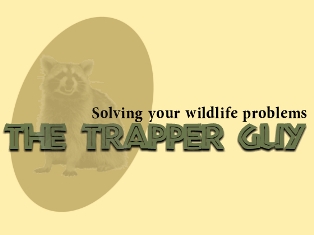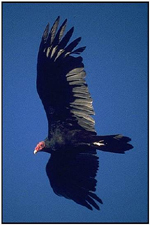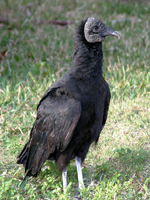| |

Call
now
to solve your Vulture problems.
727-710-0373
Serving
Tampa Bay area, FL with humane
wildlife control 24 hrs a day*
and 7 days a week
Click
here for a free estimate
Vultures or "Buzzards"
are birds of prey that are largely
scavengers. These are the large
birds you see on the side of the
highway eating "roadkill".
There
are 2 species of vultures in the
Tampa Bay area, The Turkey Vulture
and the smaller Black Vulture.
Vultures
cause problems when they roost
in mass on roofs, pool cages,
etc. The are large birds and leave
droppings and also damage roofs
with their talons and beaks.
Call
today to have your Vulture problem
resolved!
727-710-0373
|
Vultures
in Florida
by Shannon
L Ruby
There
are two distinct types of vultures in
Florida. The black vulture, Coragyps
atratus, tends to be a bit smaller than
the turkey vulture, Cathartes aura.
Both, however, are often called buzzards
or carrion crows but are not related
to either family. Both are found statewide,
share similar habitats, diets, behaviors,
and create similar problems for people.
The black vulture and turkey vulture
are protected by Federal law and cannot
be killed without proper permits from
the U.S. Fish and Wildlife Service.
The major differences
in these two birds are their appearance.
The black vulture is approximately twenty-two
inches in height and weighs 3.8 to 5.1
pounds. Its wingspan is approximately
fifty-four inches and the bird is a
dull black. It can be distinguished
by wrinkles that cover the head and
face, it has white tips on the each
wing, the tips of their bills are grayish
in color, the legs are a whitish color,
have rounded tails, and their feet extend
past their tails during flight.
The turkey vulture is
approximately twenty-five inches tall
and weighs from 3.5 to 5.3 pounds. The
wingspan is larger than its counterpart
at seventy-two inches. This bird is
blackish brown and has its own distinguishing
features. The turkey vulture has a red
head and legs, the tips of the bills
are white, and the undersides of their
wings are lined in gray. In flight,
their tails extend past their legs,
just the opposite of the black vulture.
Both vultures live in
landfills, pastures, or wherever they
can find sources of carrion (dead or
decaying flesh). They will occasionally
eat vegetable and plant matter or prey
upon young, sick, or weak animals but
carrion is their main diet. One difference
between the diets is that turkey vultures
have a well-developed sense of smell
to help them find new sources of carrion.
The black vulture will typically return
to dependable food sources rather than
seeking out new ones. Vultures are highly
gregarious (social), fly in small groups
to food sources and breed annually with
the same mate. Eggs are laid on the
ground in a dense thicket, scrub area,
hollow log, cave, or old building. The
black vulture will lay one to four egg
clutches from February to June. Its
eggs hatch in thirty-five to forty days
with a nestling period of seventy to
one hundred days. The turkey vulture
also lays one to four clutches of eggs,
but does so from March to July. The
eggs hatch in thirty-five to forty days,
but the nestling period is only fifty-five
to ninety days.
Vultures are communal
roosters and have two interesting (if
I may say) habits. Vultures defecate
on their legs to keep cool, why do it
if it doesn’t work? Also, when threatened
with attack, vultures disgorge their
stomach contents. I guess now we know
why the mention of the word vulture
conjures up such ill feelings. Horror
movies and Disney cartoons also portray
vultures in a negative light, inhabiting
dark, deserted, desolate places. Historically,
vultures have had cultural importance.
They were once thought of a spiritual
messengers (sometimes gods) and symbols
of strength. They still are important
as natural garbage disposals that eliminate
costly cleanup of our roads and pastures.
Today we think of vultures
as scavengers of road kill and often
a nuisance. Vultures can damage window
caulking, asphalt roof shingles, vinyl
seat covers from boats, tractors, and
cars. They damage swimming pool covers
and enclosures, boat canopies, and plastic
flowers at cemeteries. Their feces can
deface and damage roofs, electrical
transmission towers, and other perching
structures. Vultures may also kill calves
and other newborn livestock. As stated
earlier, Federal law protects vultures
so the best ways to solve vulture problems
is by excluding them from areas or by
using repellents. There are legal aspects
to trapping and shooting so think before
you act.
Shannon
L. Ruby is the Natural Resources/Agriculture
Agent with the University of Florida/IFAS
and Lee County Extension Service. To
submit questions, call 461-7515 between
9am and 4pm or send questions to 3406
Palm Beach Blvd. Fort Myers, FL 33916-3736
or via e-mail at rubys@leegov.com. |
|
|

Registered
and insured nuisance wildlife
trapper. Let me help
you with your vulture
problems.
|
| 
About
Dave
The
Trapper Guy is not a pest control
company. I do not
use poisons or service bugs.
|

|
|